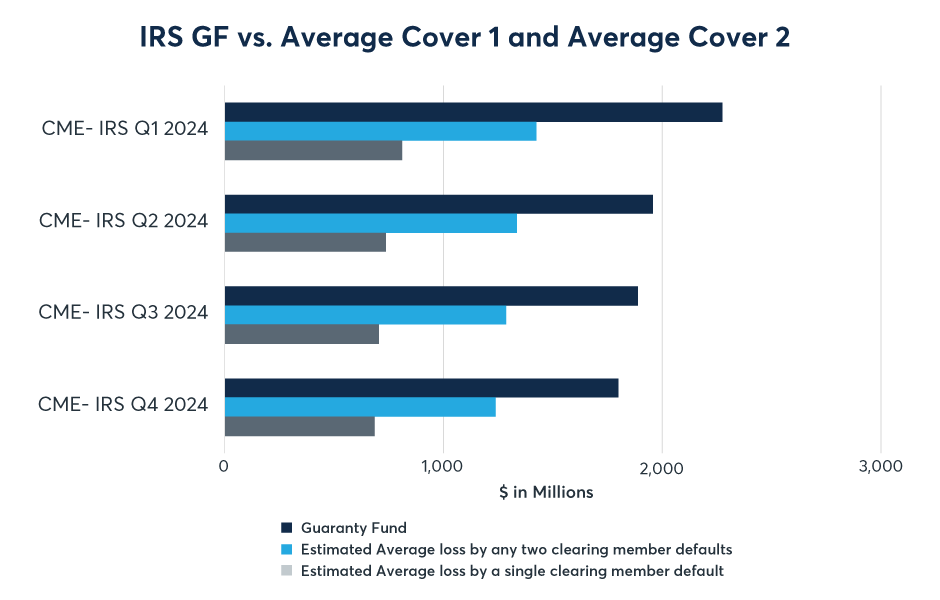
- 16 Jul 2020
- By CME Group
- Topics: Clearing
Each of CME Clearing’s guaranty funds are sized to cover the default of the two clearing members (and their affiliates) with the largest anticipated stress shortfalls – often referred to as the “Cover 2 standard.” The adequacy of each guaranty fund is assessed through daily stress testing that covers a variety scenarios capturing extreme but plausible market conditions.
Daily stress testing is designed to ensure that the guaranty funds are continually meeting the Cover 2 standard. In addition to using scenarios that capture a variety of market events, CME Clearing utilizes a guaranty fund buffer that is sized to mitigate the potential likelihood of any Cover 2 breaches.
CME Clearing’s scenarios-based approach to stress testing utilizes both historical and hypothetical scenarios that identify extreme movements in price and volatility across various risk factors. For base and IRS products, stress testing scenarios are designed to ensure that extreme historical events are captured through utilizing data from a prudent lookback period. CME Clearing’s stress testing also utilizes a confidence level of at least 99.9%. Stress testing scenarios are also specifically designed to capture the unique risks of the products covered by the base and IRS products’ financial safeguards waterfalls.
CME Clearing continually evaluates its stress testing scenarioset, including its appropriateness for the current market environment. While CME Clearing’s stress testing is designed to capture a breadth of extreme but plausible market conditions, this evaluation allows CME Clearing to react appropriately to market developments. On at least a monthly basis, CME Clearing reviews its stress testing scenarios and assesses whether they continue to be appropriate based on current market conditions and makes appropriate adjustments as necessary.
Summary stress testing results are provided to the Clearing House Oversight Committee1 and the CME Clearing Risk Committees2, which are comprised of members of CME Group’s board of directors, and clearing member and market participant representatives, respectively. CME Clearing’s stress testing framework is also evaluated through the annual validation process conducted by independent experts.
CME Clearing also routinely conducts reverse stress testing on the overall size of the guaranty funds, which is designed to identify market conditions that may exhaust the resources of the guaranty funds. These conditions are captured using extreme but implausible scenarios. The results of reverse stress testing are reviewed at least monthly to help inform overall stress testing practices and analyze exposures in given products. Reverse stress testing offers insight into the potential results of severe and unexpected changes for given products cleared and clearing members’ portfolios
The charts above show the estimated largest aggregate stress loss that would be caused by the default of both a single clearing member and its affiliates (i.e., Cover 1) and of any two clearing members and their affiliates (i.e., Cover 2) under extreme but plausible market conditions, on average over the previous 12-months for both base and IRS products.
Data points on CME Clearing’s guaranty fund coverage are disclosed under Disclosure 4.4 of the CME Clearing Quantitative PFMI Disclosure document.3
- CHOC Composition & Charter: http://investor.cmegroup.com/committee-details/clearing-house-oversight
- CHRC Charter: http://investor.cmegroup.com/committee-details/clearing-house-risk-committee and IRSRC Charter: http://investor.cmegroup.com/committee-details/irs-risk-committee
- https://www.cmegroup.com/clearing/cpmi-iosco-reporting.html.
About CME Group
As the world’s leading derivatives marketplace, CME Group is where the world comes to manage risk. Comprised of four exchanges - CME, CBOT, NYMEX and COMEX - we offer the widest range of global benchmark products across all major asset classes, helping businesses everywhere mitigate the myriad of risks they face in today's uncertain global economy.
Follow us for global economic and financial news.

